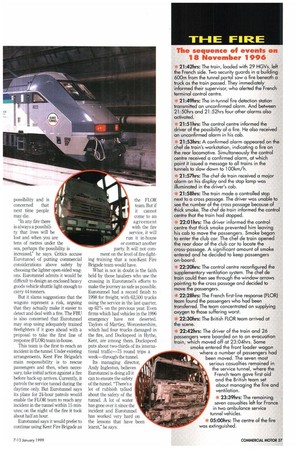TI-I E FIRE
Page 39

If you've noticed an error in this article please click here to report it so we can fix it.
The sequence of events on 18 November 1996
21:42hrs: The train, loaded with 29 HGVs, left the French side. Two security guards in a building 600m from the tunnel portal saw a fire beneath a truck as the train passed. They immediately informed their supervisor, who alerted the French terminal control centre.
21:49hrs: The in-tunnel fire detection station transmitted an unconfirmed alarm. And between 21:50hrs and 21-52hrs four other alarms also activated.
• 21:51hrs: The control centre informed the driver of the possibility of a fire. He also received an unconfirmed alarm in his cab.
• 21:53hrs: A confirmed alarm appeared on the chef de train's workstation, indicating a fire on the rear locomotive. Simultaneously the control centre received a confirmed aiarm, at which point it issued a message to all trains in the tunnels to slow down to 100km/k.
2I:57hrs: The chef de train received a major alarm on his display and the stop lamp was illuminated in the driver's cab.
• 21:58hrs: The train made a controlled stop next to a cross passage. The driver was unabie to see the number of the cross passage because of thick smoke. The chef de train informed the control centre that the train had stopped.
22:0Ihrs: The driver informed the controi centre that thick smoke prevented him leaving his cab to move the passengers. Smoke began to enter the club car. The chef de train opened the rear door of the club car to locate the cross-passage. A significant amount of smoke entered and he decided to keep passengers on-board.
22:20hrs: The control centre reconfigured the supplementary ventilation system. The chef de train could then see through the window arrows pointing to the cross passage and decided to move the passengers.
22:28hrs: The French first-line response (FLOR) team found the passengers who had been transferred. The team concentrated on supplying oxygen to those suffering worst.
22:30hrs: The British FLOR team arrived at the scene.
* 22:42hrs: The driver of the train and 26 passengers were boarded on to an evacuation train, which moved off at 23:04hrs. Some smoke entered the front loader wagon
where a number of passengers had been moved. The seven most serious casualties remained in the service tunnel, where the French team gave first aid and the British team set about managing the fire and ventilation, 23:39hr5: The remaining seven casualties left for France in two ambulance service tunnel vehicles.
05:00hrs: The centre of the fire was extinguished.
































































































